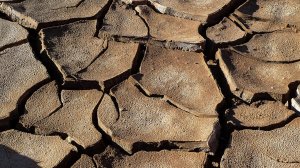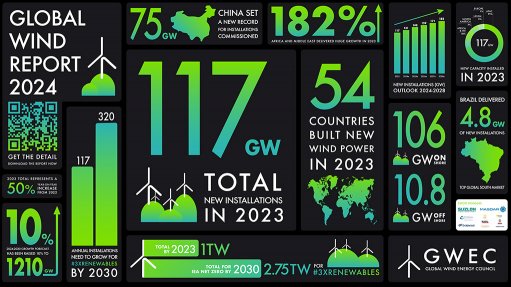CSIR projects drastic temperature increase over Africa
The upcoming summer season in Southern Africa, between December and February, could be the warmest ever recorded, Council for Scientific and Industrial Research (CSIR) principal researcher Dr Francois Engelbrecht said on Thursday.
A new study, entitled 'Projections of rapidly rising surface temperatures over Africa under low mitigation', lead by Engelbrecht, noted that this was owing to climate change as well as a “super” El Nino event currently developing in the Pacific Ocean.
Speaking to Engineering News Online on the sidelines of his presentation at the CSIR, Engelbrecht noted that temperatures in the central and eastern Pacific Ocean were already 2 ºC above what was considered normal.
“If this El Nino continues to intensify, the average temperature in the central Pacific Ocean could go even higher, exceeding the current record of 2.3 ºC,” he said.
Engelbrecht added that, as a result, there was an increased likelihood of drought in the region, which was projected by most climate models to become drier, while East Africa would become wetter.
He highlighted that through a representative concentration pathway (RCP), which was an emission scenario in which greenhouse gases were expected to change over time, research showed how temperatures could rise over the next century.
Meanwhile, temperatures over subtropical Southern Africa had risen at more than twice the global rate over the last five decades. Warming of between 4 ºC and 6 ºC over the subtropics and 3 ºC and 5 ºC over the tropics was also projected by the end of the century under low mitigation, relative to the present-day climate.
The study used a regional climate model integrated on a powerful computer-cluster at its Centre for High Performance Computing, to obtain detailed projections of future climate change over Africa.
This study was ahead of the United Nations Framework Convention on Climate Change twenty-first Conference of the Parties, or COP 21, due to take place in Paris, France, in November. This meeting aimed to achieve a legally binding and universal agreement on climate, with the aim of keeping global warming below 2 ºC.
“If the negotiations fail to ensure a high-mitigation future, we are likely to see rapidly rising surface temperature across [Africa],” Engelbrecht explained.
He added that he did expect a new treaty to be signed during the meeting, but he doubted if it would be effective enough. “If I look at current evidence available, the treaty is not going to be as strong as we are hoping it will be. It is unlikely that it will be sufficient to ensure that we attain the global goal, to keep temperatures below 2 ºC. It is more likely that we will exceed that threshold and become a 3 ºC to 4 ºC warmer world during this century,” Engelbrecht warned.
Africa was particularly vulnerable to excessive temperature increases owing to the continent’s dependence on subsistence farming and rain-fed agriculture. “For many regions, the impact of temperature increases on the agricultural and biodiversity sectors may be significant, stemming from temperature-related extreme events such as heat-waves, wild fires and agricultural drought.
“Globally, Africa is the single largest source of biomass burning emissions. It is very important to understand the impact of the increasing occurrences of fires on the African savannas, as well as potential feedbacks to the regional and global climate system,” he highlighted.
The paper also revealed that general reductions in soil-moisture could occur across the continent, as a result of enhanced evaporation that occurred in response to increasing surface temperatures.
“In the subtropics, this effectively implies a longer burning season and a shorter growing season,” said Engelbrecht.
He added that while El Ninos only occurred every two to seven years, there would likely be an increase in future. “The question is, is climate change going to bring more El Nino events or fewer? On current climate model projections, there is no certainty, but there is certainty that the super El Nino events will increase in frequency.”
Comments
Press Office
Announcements
What's On
Subscribe to improve your user experience...
Option 1 (equivalent of R125 a month):
Receive a weekly copy of Creamer Media's Engineering News & Mining Weekly magazine
(print copy for those in South Africa and e-magazine for those outside of South Africa)
Receive daily email newsletters
Access to full search results
Access archive of magazine back copies
Access to Projects in Progress
Access to ONE Research Report of your choice in PDF format
Option 2 (equivalent of R375 a month):
All benefits from Option 1
PLUS
Access to Creamer Media's Research Channel Africa for ALL Research Reports, in PDF format, on various industrial and mining sectors
including Electricity; Water; Energy Transition; Hydrogen; Roads, Rail and Ports; Coal; Gold; Platinum; Battery Metals; etc.
Already a subscriber?
Forgotten your password?
Receive weekly copy of Creamer Media's Engineering News & Mining Weekly magazine (print copy for those in South Africa and e-magazine for those outside of South Africa)
➕
Recieve daily email newsletters
➕
Access to full search results
➕
Access archive of magazine back copies
➕
Access to Projects in Progress
➕
Access to ONE Research Report of your choice in PDF format
RESEARCH CHANNEL AFRICA
R4500 (equivalent of R375 a month)
SUBSCRIBEAll benefits from Option 1
➕
Access to Creamer Media's Research Channel Africa for ALL Research Reports on various industrial and mining sectors, in PDF format, including on:
Electricity
➕
Water
➕
Energy Transition
➕
Hydrogen
➕
Roads, Rail and Ports
➕
Coal
➕
Gold
➕
Platinum
➕
Battery Metals
➕
etc.
Receive all benefits from Option 1 or Option 2 delivered to numerous people at your company
➕
Multiple User names and Passwords for simultaneous log-ins
➕
Intranet integration access to all in your organisation





















